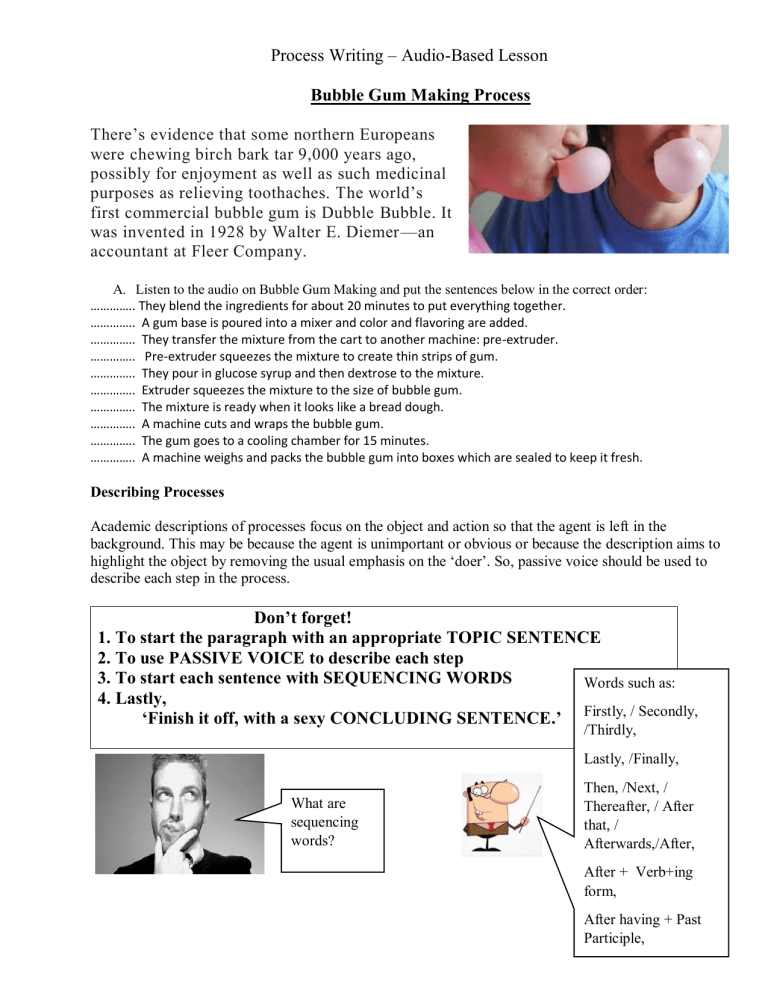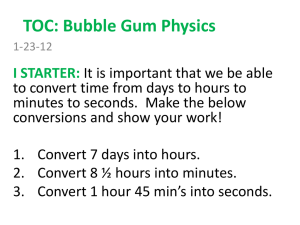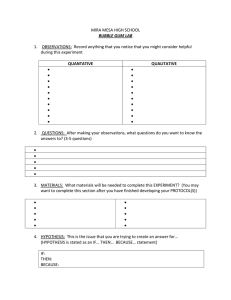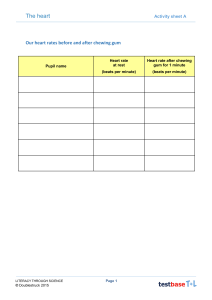
Process Writing – Audio-Based Lesson Bubble Gum Making Process There’s evidence that some northern Europeans were chewing birch bark tar 9,000 years ago, possibly for enjoyment as well as such medicinal purposes as relieving toothaches. The world’s first commercial bubble gum is Dubble Bubble. It was invented in 1928 by Walter E. Diemer—an accountant at Fleer Company. A. Listen to the audio on Bubble Gum Making and put the sentences below in the correct order: ………….. They blend the ingredients for about 20 minutes to put everything together. ………….. A gum base is poured into a mixer and color and flavoring are added. ………….. They transfer the mixture from the cart to another machine: pre-extruder. ………….. Pre-extruder squeezes the mixture to create thin strips of gum. ………….. They pour in glucose syrup and then dextrose to the mixture. ………….. Extruder squeezes the mixture to the size of bubble gum. ………….. The mixture is ready when it looks like a bread dough. ………….. A machine cuts and wraps the bubble gum. ………….. The gum goes to a cooling chamber for 15 minutes. ………….. A machine weighs and packs the bubble gum into boxes which are sealed to keep it fresh. Describing Processes Academic descriptions of processes focus on the object and action so that the agent is left in the background. This may be because the agent is unimportant or obvious or because the description aims to highlight the object by removing the usual emphasis on the ‘doer’. So, passive voice should be used to describe each step in the process. Don’t forget! 1. To start the paragraph with an appropriate TOPIC SENTENCE 2. To use PASSIVE VOICE to describe each step 3. To start each sentence with SEQUENCING WORDS Words such as: 4. Lastly, ‘Finish it off, with a sexy CONCLUDING SENTENCE.’ Firstly, / Secondly, /Thirdly, Lastly, /Finally, What are sequencing words? Then, /Next, / Thereafter, / After that, / Afterwards,/After, After + Verb+ing form, After having + Past Participle, Process Writing – Audio-Based Lesson Simple Present Passive Formation Active voice: Technician pours the gum base into the mixture. Subject Technician Verb pours Object the gum base………… Passive voice: Object of an active sentence + is/am/are + past participle form +rest of the sentence Object (new subject) Verb Object Rest of the sentence is poured into the mixture The gum base It is not important to say who performs an action in a passive sentence. If you want to add an agent to the sentence you use “by + doer”, e.g. by a technician B. The following steps in Bubble Gum production are in active voice. Change them into passive. The first one is done for you. Example: Bubble gum makers pour the gum base into the mixer. The gum base is poured into the mixer. 1. They add colour and flavouring to the gum base. …………………………………………………………………………………………………………….. 2. They add glucose syrup and dextrose to the mixture. ……………………………………………………………………………………………………………… 3. The machine blends the ingredients for about 20 minutes until it looks like a bread dough. ……………………………………………………………………………………………………………… 4. They transfer the dough to pre-extruder. …………………………………………………………………………………………..…………………. 5. Pre- extruder squeezes the bulky wad to manageable stripes. ……………………………………………………………………………………………………………… 6. The extruder squeezes each strip down to the actual width of a piece of bubble gum. ……………………………………………………………………………………………………………… 7. Cooling machine cools bubble gum stripes for 15 minutes. ……………………………………………………………………………………………………………… 8. Wrapping machine cuts these into bite-sized pieces and wraps them in wax paper. ……………………………………………………………………………………………………………… Process Writing – Audio-Based Lesson C. Connect the above sentences to form a paragraph on the bubble gum making process. Use sequencing words and finish it with an appropriate concluding sentence. The topic sentence has been written for you. Bubble gum making process consists of nine steps from pouring the gum base into the mixer to packing the bubble gum in boxes before distribution. …………………………………………………………………………………………..………………… ……………………………………………………………………………………………………………… .……………………………………………………………………………………………………………… ……………………………………………………………………………………………………………… ……………………………………………………………………………………………………………… ……………………………………………………………………………………………………………… ……………………………………………………………………………………………………………… ……………………………………………………………………………………………………………… ……………………………………………………………………………………………………………… ……………………………………………………………………………………………………………… .……………………………………………………………………………………………………………… ……………………………………………………………………………………………………………… ……………………………………………………………………………………………………………… ……………………………………………………………………………………………………………… ……………………………………………………………………………………………………………… ……………………………………………………………………………………………………………… ……………………………………………………………………………………………………………… Paper making process D. Listen to the audio carefully and match activities happening in the paper making process with their respective purpose. The first one is done for you. Activity 1.Use of conifer tress such as Spruce, Fir and Pine 2.Cooking woodchips in acidic solution 3.Bleaching the cooked pulp 4.Bleaching without using chlorine agents 5.Passing the pulp through a series of rotating and stationary blades 6.Adding Calcium Carbonate and clay into the pulp Purpose a.To protect the environment b.To give fibers a variable degree of clean-cut or fibrillated ends c.To dissolve lignin and separate plant fiber d.To make the paper more opaque and controlled in density e.To make stronger variety of paper f.To remove residual lignin that makes paper to yellow with age Process Writing – Audio-Based Lesson E. Listen to the audio again. Main steps of the pulp production at the wood yard are given below. Listen to it again and fill in the banks with the correct form of the verb from the given box. (feed x 3, chip , transport , cook ,wash ,bleach , filter out , mix x 2 , refine, add) The paper making process at the pulp mill consists of……….. steps from ………….the logs into the rotating drum to……………. various chemicals to improve the appearance of paper. Firstly, the logs ……………. into a rotating drum which removes the bark. Logs ………..then ……………... Next, the wood chips ……………………………………..to the pulp mill on a conveyer belt. Afterwards, woodchips………………………….into a digester where they ………………………………… in an acid solution. After having cooked in an acidic solution, fibers ……………………………..to remove the acid solution. After washing, pulp …………………………. and any residual lignin which would cause the paper to yellow with age ………………………. .Before the water treatment, the treated pulp is dried, bailed and transported to the paper mill. Thereafter, the treated pulp…………………………… with water. Further, the pulp solution ………………………………. by passing it through a series of rotating and stationary blades. Then, Calcium Carbonate and clay …………………. in to make the paper more opaque and controlled in density. Finally, dyes and optical brighteners are also blended into the pulp to improve the appearance of the paper. The pulp solution is now a carefully controlled mix of fibers fillers and coloring agents suspended in water ready to enter the paper machine Chanel No. 5 perfume making In 1921, a clever French businesswoman created a scent that revolutionized the way women smell. Ninety years later Chanel No 5 is arguably still the world's most iconic perfume. F. ACTIVITY Step 1: Listen to an interview with Chanel employee describing the production process for Chanel No.5 Step 2: Listen again and make notes on the main steps you listen. Step 3: Write a paragraph on Chanel No.5 perfume making process. - incorporate a topic sentence, basic steps and a concluding sentence. You will hear some of the words given below extracting solvent=the partial removal of a substance from a solution by dissolving it in another, vats=a large tank or tub used to hold liquid, especially in industry. absolute= concentrated, highly aromatic, oily mixtures extracted from plants. Process Writing – Audio-Based Lesson





